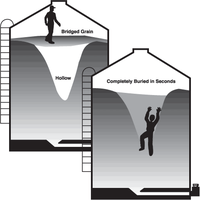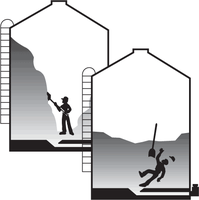Don’t Get Caught in Grain
(Click an image below to view a high-resolution image that can be downloaded)
-

Grain kernels may stick together, forming a crust or bridge. A hollow may develop under the crust when grain is removed from the bin. The bridge can collapse under a person's weight, burying the person in seconds. -

After some grain has been removed, some of the rest may remain stuck together in a large pile or wall. Breaking it loose can be very risky.
If you are working with grain, you need to know how to keep from getting trapped in it.
A lot of wetter-than-normal corn went into storage this year, and wet corn is more prone to crusting or creating a wall of grain near the grain bin wall, warns Ken Hellevang, North Dakota State University Extension Service engineer. At least one North Dakotan has died from being trapped in grain this winter.
People can become trapped in three ways: flowing grain, the collapse of a vertical wall of grain and the collapse of bridged grain.
Bridging occurs when grain is high in moisture content, moldy or in poor condition. The kernels stick together and form a crust. A cavity will form under the crust when grain is removed from the bin. The crust isn’t strong enough to support a person’s weight, so anyone who walks on it will fall into the cavity and be buried under several feet of grain.
A wall of grain can collapse without warning and cover a person. Flowing grain will pull a person into the grain mass, burying the person in a few seconds.
Hellevang offers these tips to help keep farmers and elevator personnel safe:
- To determine if the grain is bridged, look for a funnel shape on the surface of the grain mass after some grain has been removed. If the grain surface appears undisturbed, the grain has bridged and a cavity has formed under the surface.
- Do not attempt to stand on the grain bridge or enter the grain bin to break it loose. Instead, stay outside the bin and use a pole or other object to break the bridge. Tie the pole or other object to a rope attached to the bin so you can retrieve the pole if you drop it.
- If the grain flow stops when you’re removing it from the bin but the grain surface has a funnel shape and shows some evidence that the grain has been flowing into the auger, a chunk of crusted grain probably has gotten into the auger and is blocking the flow.
- Do not enter a bin to dislodge grain that has formed a wall or other large mass. Instead, try to break up the mass from the top of the bin with a long pole on a rope or through a door with a long pole.
- Do not allow anyone to work around stored grain until they have been warned about the hazards. NDSU publication AE-1102, “Caught in the Grain,” can help educate people about the dangers. It’s available at http://www.ag.ndsu.edu/pubs/ageng/safety/ae1102w.htm.
- Place decals warning of the dangers of flowing grain at all bin entrances, on rail cars and truck and trailer boxes used for hauling grain and on gravity discharge wagons.
- Never enter a grain bin without stopping the auger and using the “lock-out/tag-out” procedures to secure it. Use a key-type padlock to lock the auger switch in the “off” position.
- Never enter a grain bin alone. Have at least two people at the bin to assist in case of problems. Use a safety harness or line when entering a bin.
Here is what to do if someone gets trapped:
- Shut off all grain-moving machinery to stop the flow of grain.
- Contact your local emergency rescue service or fire department.
- Ventilate the bin using the fan.
- Form retaining walls around the person with plywood, sheet metal or other material to keep grain from flowing toward the person, then remove grain from around the person. Don’t try to pull a person out of flowing grain if it is up to the person’s waist or higher. The grain exerts tremendous pressure on the body, so trying to pull a person out could damage his or her spinal column.
- Cut holes in the bin sides to remove grain if the person is submerged. Use a cutting torch, metal-cutting power saw or air chisel to cut at least two V- or U-shaped holes on opposite sides or more holes equally spaced around the bin. Grain flowing from just one hole may injure the trapped person and cause the bin to collapse.
NDSU Agriculture Communication
| Source: | Ken Hellevang, (701) 231-7243, kenneth.hellevang@ndsu.edu |
|---|---|
| Editor: | Ellen Crawford, (701) 231-5391, ellen.crawford@ndsu.edu |
Attachments
- PDF - Grain kernels may stick together, forming a crust or bridge. A hollow may develop under the crust when grain is removed from the bin. The bridge can collapse under a person's weight, burying the person in seconds. - (19.4853515625 kb)
- EPS - Grain kernels may stick together, forming a crust or bridge. A hollow may develop under the crust when grain is removed from the bin. The bridge can collapse under a person's weight, burying the person in seconds. - (125.2236328125 kb)
- PDF - After some grain has been removed, some of the rest may remain stuck together in a large pile or wall. Breaking it loose can be very risky. - (15.3662109375 kb)
- EPS - After some grain has been removed, some of the rest may remain stuck together in a large pile or wall. Breaking it loose can be very risky. - (84.7626953125 kb)

